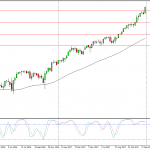
It was almost exactly 10 years ago that then Citibank boss, Chuck Prince, unintentionally highlighted the approach of the subprime crisis with his comment that:
‘We are not scared. We are not panicked. We are not rattled. Our team has been through this before.’ We are ’still dancing’.”
On Friday JP Morgan’s CEO, Jamie Dimon, provided a new and more considered warning:
“Since the Great Recession, which is now 8 years old, we’ve been growing at 1.5% – 2% in spite of stupidity and political gridlock…. We have become one of the most bureaucratic, confusing, litigious societies on the planet. It’s almost an embarrassment being an American citizen traveling around the world and listening to the stupid s— we have to deal with in this country. And at one point we all have to get our act together or we won’t do what we’re supposed to [do] for the average Americans.”
The chart above, from OECD data, highlights one key result of the dysfunctionality that Dimon describes:
? Central bank stimulus has proved to be a complete failure, as it cannot compensate for today’s “demographic deficit”
? UK debt as a percentage of GDP has more than doubled from 51% in 2007 to 123% last year
? US debt has risen from an already high 77% in 2007 to 128% last year
? Japanese debt has risen from an insane 175% in 2007 to an impossible-to-repay 240%
Debt is essentially just a way of bringing forward demand from the future. If I can borrow money today, I don’t have to wait till tomorrow to buy what I need. But, I do then have to pay back the debt – I can’t borrow forever. So high levels of debt inevitably create major headwinds for future growth.

Unfortunately, central banks and their admirers thought this simple rule didn’t apply to them. They imagined they could print as much money as they liked – and then, magically, all the debt would disappear through a mix of economic growth and inflation. But as the second chart shows, they were completely wrong:













Leave A Comment